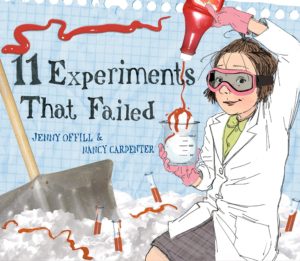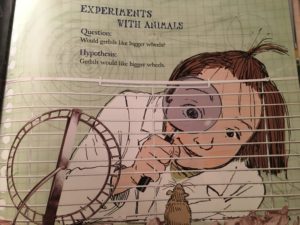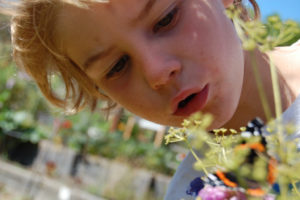Why I Picked It Up: I thought it was a clever non-fiction book about how some lesser known scientists persevered through failure to invent amazing things. Clearly, I was in a hurry at the library and didn’t study the cover very carefully!
Why I Finished It: We were all rolling on the floor! It didn’t take long to realize that 11 Experiments That Failed was actually a fictional story about a budding scientist who experiments with things around her, much to the distress of her family members and pets. As the title suggests, she’s not very successful in her experiments, but the aftermath is hilarious!
It’s a very relatable book, especially for curious kids and for the stressed-out parents and teachers of those curious kids as well. Some of the questions that drive experiments are: Can a kid make it through the winter eating only snow and ketchup? Is there a way to make stinky cheese smell better? Our favorite: Do dogs like to be covered in glitter? I really felt I could identify with the harried-looking mother in the book who was constantly trying to run damage control as her daughter industriously worked to satisfy her curiosity with crazy experiments!
The text on the page is minimal. It reads like a lab notebook outlining each experiment with Question, Hypothesis, What You Need, What to Do, and What Happened. However, there is lots of room for inference based on background knowledge and visual cues from the illustrations that tell most of the actual story. The mixed media illustrations are really fun to study and add a great layer of detail!
Oh, and Jenny Offill also wrote, Sparky!, a hilarious book filled with great vocabulary and characterization that you can read about in our post here. I knew I liked her!
Who I Would Give It To: All elementary teachers who deal with inquisitive, curious minds on a daily basis, but especially science teachers to read aloud as a fun, cautionary way to enter into science fair season or to look at the scientific method.
Integration Ideas
Scientific Method
11 Experiments That Failed is the perfect introduction or reminder of the steps in the scientific method. It takes away some of the stigma associated with formal science experiments and shows off the scientific method in a very natural light, as a means to explore observation and answer questions.
Each experiment spans two or three pages and clearly follows the steps that students will follow in other, more academic, experiments. A few of them are set up well to have students extrapolate the scientific method on their own before they find out what she does and what she learns.
Start by reading the question: Would gerbils like bigger wheels? Have students decide if they agree with her hypothesis or not. Spend time discussing reasons for their answers – What makes you say that? What experience have you had with gerbils? What do you know about gerbils? This will help activate background knowledge and help students start making connections.
Before showing them how the girl goes about experimenting, have students plan the experiment. How could we determine if a gerbil would like a bigger wheel or not? What materials will they need? What are the steps they would follow in the experiment? Have students record their plan in a science or writing journal.
Then, show the students what it says in the book, see if their predictions were correct and how their experiment compares to the one she does in the book.
Asking Questions & Padlet Integration
The girl in the story is always asking questions! She isn’t going anywhere out of the ordinary or doing anything a normal elementary student wouldn’t do, but she is observant and curious.
Asking questions is an important part of developing great readers and thinkers. As students read or interact with the world, they need to be able to slow down and think about what they are reading, make connections, and really engage with what they are reading or seeing.
Curiosity is also an important skill that drives inquiry, and as students get older, that skill can fade for any number of reasons.
Even though student curiosity may not always be timed well for that day’s schedule, or may not even relate to what we’re talking about. Creating a student-directed space to honor student curiosity can help you stay on track without potentially extinguishing their wonder or questioning.
Padlet (or a similar tool) is a great (easy!) digital option for this. As students come up with questions, they can post their question to the Padlet. Maybe you set aside a class time once a week to address questions. Maybe students can go to the Padlet if they’ve finished an assignment early and they can pick a question to research (theirs or someone else’s!), posting the information they find as a response to help satisfy others’ curiosity. Digital sticky notes allow students to incorporate multimedia into their questions or answers, and really expand the learning experience.
Here’s a sample Padlet. Try it out – post a question and see if someone answers it!
Padlet, available on the web or through the iOS, Android, and Chrome apps, is free for 12 Padlets. It has several levels of privacy – from completely public to password protected to completely secret. As you create a Padlet, you can choose a structure for it (backchannel chat, random, Pinterest style blocks, etc.), you can set the URL, decide if you want to moderate the posts, etc.
Procedural Writing – Snapguide
Part of setting up a science experiment is laying out the steps or procedure you will follow to complete that experiment. Procedural writing can be a fun type of writing to practice and helps students learn to think logically and write clearly.
Have the students practice procedural writing by breaking down a task into the steps using Snapguide. This tool allows students to write text for each step, but accompany it with a picture or video of that step as well. It’s easy to use, visually engaging, and free! It’s also fun to be able to share your finished products with an authentic audience through the Snapguide platform. If you want a more thorough step-by-step guide to using Snapguide, check out our post here: App/Website Review: Snapguide.
Students could also analyze Snapguides that already exist. There are plenty of recipes and DIY projects, but you can also find school-related Snapguides if you search for a particular topic. Maybe students try following the steps outlined by the author of the guide to analyze the effectiveness of the procedural writing. If necessary, they can rewrite it or suggest improvements based on their own procedural writing skills.
Bring it All Together
You don’t have to wait for science fair time to do this! As students learn to record their curiosity and ask insightful questions, that will naturally lead to their own science experiments! Allow students to plan their own science experiment, based on their question. They’ll need to follow the scientific method, plan the procedure thoroughly and write the steps, and finally, execute it!











Leave a Reply